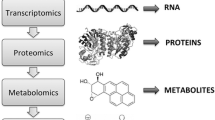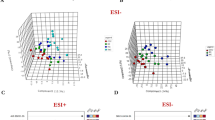Abstract
Background
Previous metabolomic studies have revealed that plasma metabolic signatures may predict epithelial ovarian cancer (EOC) recurrence. However, few studies have performed metabolic profiling of pre- and post-operative specimens to investigate EOC prognostic biomarkers.
Objective
The aims of our study were to compare the predictive performance of pre- and post-operative specimens and to create a better model for recurrence by combining biomarkers from both metabolic signatures.
Methods
Thirty-five paired plasma samples were collected from 35 EOC patients before and after surgery. The patients were followed-up until December, 2016 to obtain recurrence information. Metabolomics using rapid resolution liquid chromatography–mass spectrometry was performed to identify metabolic signatures related to EOC recurrence. The support vector machine model was employed to predict EOC recurrence using identified biomarkers.
Results
Global metabolomic profiles distinguished recurrent from non-recurrent EOC using both pre- and post-operative plasma. Ten common significant biomarkers, hydroxyphenyllactic acid, uric acid, creatinine, lysine, 3-(3,5-diiodo-4-hydroxyphenyl) lactate, phosphohydroxypyruvic acid, carnitine, coproporphyrinogen, l-beta-aspartyl-l-glutamic acid and 24,25-hydroxyvitamin D3, were identified as predictive biomarkers for EOC recurrence. The area under the receiver operating characteristic (AUC) values in pre- and post-operative plasma were 0.815 and 0.909, respectively; the AUC value after combining the two sets reached 0.964.
Conclusion
Plasma metabolomic analysis could be used to predict EOC recurrence. While post-operative biomarkers have a predictive advantage over pre-operative biomarkers, combining pre- and post-operative biomarkers showed the best predictive performance and has great potential for predicting recurrent EOC.




Similar content being viewed by others
Abbreviations
- EOC:
-
Epithelial ovarian cancer
- AUC:
-
Area under the receiver operating characteristic
- RRLC/MS:
-
Rapid resolution liquid chromatography–mass spectrometry
- ESI+/−:
-
Electrospray ionization positive/negative
- QC:
-
Quality control
- PCA:
-
Principal component analysis
- PLS-DA:
-
Partial least-squares discriminant analysis
- VIP:
-
Variable importance in the projection
- SVM:
-
Support vector machine
References
Araujo, R. L., Gönen, M., Allen, P., DeMatteo, R., Kingham, P., Jarnagin, W., et al. (2015). Positive postoperative CEA is a strong predictor of recurrence for patients after resection for colorectal liver metastases. Annals of Surgical Oncology, 22, 1–7.
Bonora, E., Porcelli, A. M., Gasparre, G., Biondi, A., Ghelli, A., Carelli, V., et al. (2006). Defective oxidative phosphorylation in thyroid oncocytic carcinoma is associated with pathogenic mitochondrial DNA mutations affecting complexes I and III. Cancer Research, 66, 6087.
Boulesteix, A. L. (2005). Dimension reduction and Classification with High-Dimensional Microarray Data. München: Ludwig-Maximilians-Universität.
Burges, C. J. C. (1998). A tutorial on support vector machines for pattern recognition. Data Mining & Knowledge Discovery, 2, 121–167.
Carew, J. S., & Huang, P. (2002). Mitochondrial defects in cancer. Molecular cancer, 1, 9.
Cheng, J., Zheng, G., Jin, H., & Gao, X. (2017). Towards tyrosine metabolism in esophageal squamous cell carcinoma. Combinatorial Chemistry & High Throughput Screening, 20, 133.
Colombo, P. E., Fabbro, M., Theillet, C., Bibeau, F., Rouanet, P., & Raycoquard, I. (2014). Sensitivity and resistance to treatment in the primary management of epithelial ovarian cancer. Critical Reviews in Oncology/Hematology, 89, 207.
Das, U. N. (2006). Essential fatty acids: biochemistry, physiology and pathology. Biotechnology Journal, 1, 420.
Fan, L., Zhang, W., Yin, M., Zhang, T., Wu, X., Zhang, H., et al. (2012). Identification of metabolic biomarkers to diagnose epithelial ovarian cancer using a UPLC/QTOF/MS platform. Acta Oncologica, 51, 473.
Fan, X. M., Zhang, J., Niu, S. H., Li, K. X., & Song, C. Z. (2016). Secondary cytoreductive surgery in recurrent epithelial ovarian cancer: A prognostic analysis with 103 cases. International Journal of Surgery, 38, 61–66.
Faye, A., Esnous, C., Price, N. T., Onfray, M. A., Girard, J., & Pripbuus, C. (2007). Rat liver carnitine palmitoyltransferase 1 forms an oligomeric complex within the outer mitochondrial membrane. Journal of Biological Chemistry, 282, 26908.
Fini, M. A., Orchard-Webb, D., Kosmider, B., Amon, J. D., Kelland, R., Shibao, G., et al. (2008). Migratory activity of human breast cancer cells is modulated by differential expression of xanthine oxidoreductase. Journal of Cellular Biochemistry, 105, 1008–1026.
Hille, R. (2005). Molybdenum-containing hydroxylases. Archives of Biochemistry & Biophysics, 433, 107–116.
Huang, H., Liu, N., Guo, H., Liao, S., Li, X., Yang, C., et al. (2012). L-carnitine is an endogenous HDAC inhibitor selectively inhibiting cancer cell growth in vivo and in vitro. PLoS ONE, 7, e49062.
Jaakkola, T. S., & Haussler, D. (1999). Exploiting generative models in discriminative classifiers. Advances in Neural Information Processing Systems, 11, 487–493.
Jayson, G. C., Kohn, E. C., Kitchener, H. C., & Ledermann, J. A. (2014). Ovarian cancer. Lancet, 384, 1376–1388.
Jiang, H. G., Li, J., Shi, S. B., Chen, P., Ge, L. P., Jiang, Q., et al. (2014). Value of fibrinogen and D-dimer in predicting recurrence and metastasis after radical surgery for non-small cell lung cancer. Medical Oncology, 31, 22.
Ke, C., Hou, Y., Zhang, H., Fan, L., Ge, T., Guo, B., et al. (2015). Large-scale profiling of metabolic dysregulation in ovarian cancer. International Journal of Cancer, 136, 516.
Kim, A. W., Batus, M., Myint, R., Fidler, M. J., Basu, S., Bonomi, P., et al. (2011). Prognostic value of xanthine oxidoreductase expression in patients with non-small cell lung cancer. Lung Cancer, 71, 186–190.
Kim, J. H., Lee, J., Oh, B., Kimm, K., & Koh, I. (2004). Prediction of phosphorylation sites using SVMs. Bioinformatics, 20, 3179–3184.
Kipps, E., Tan, D. S., & Kaye, S. B. (2013). Meeting the challenge of ascites in ovarian cancer: New avenues for therapy and research. Nature Reviews Cancer, 13, 273.
Kobayashi, T., Nishiumi, S., Ikeda, A., Yoshie, T., Sakai, A., Matsubara, A., et al. (2013). A novel serum metabolomics-based diagnostic approach to pancreatic cancer. Cancer Epidemiology, Biomarkers and Prevention, 22, 571–579. https://doi.org/10.1158/1055-9965.epi-12-1033.
Kuhl, C., Tautenhahn, R., Böttcher, C., Larson, T. R., & Neumann, S. (2012). CAMERA: An integrated strategy for compound spectra extraction and annotation of LC/MS data sets. Analytical Chemistry, 84, 283–289.
Liang, K.-Y., & Zeger, S. L. (1986). Longitudinal data analysis using generalized linear models. Biometrika, 73, 13–22.
Linder, N., Haglund, C., Lundin, M., Nordling, S., Ristimäki, A., Kokkola, A., et al. (2006). Decreased xanthine oxidoreductase is a predictor of poor prognosis in early-stage gastric cancer. Journal of Clinical Pathology, 59, 965–971.
Linder, N., Martelin, E., Lundin, M., Louhimo, J., Nordling, S., Haglund, C., et al. (2009). Xanthine oxidoreductase—Clinical significance in colorectal cancer and in vitro expression of the protein in human colon cancer cells. European Journal of Cancer, 45, 648–655. https://doi.org/10.1016/j.ejca.2008.10.036.
Linder, N., Bützow, R., Lassus, H., Lundin, M., & Lundin, J. (2012). Decreased xanthine oxidoreductase (XOR) is associated with a worse prognosis in patients with serous ovarian carcinoma. Gynecologic Oncology, 124, 311.
Mahadevan, S., Shah, S. L., Marrie, T. J., & Slupsky, C. M. (2008). Analysis of metabolomic data using support vector machines. Analytical Chemistry, 80, 7562–7570.
Marcus, C. S., Maxwell, G. L., Darcy, K. M., Hamilton, C. A., & Mcguire, W. P. (2014). Current approaches and challenges in managing and monitoring treatment response in ovarian cancer. Journal of Cancer, 5, 25.
Netke, S. P., Roomi, M. W., Ivanov, V., Niedzwieki, A., & Rath, M. (2003). A specific combination of ascorbic acid, lysine, proline and epigallocatechin gallate inhibits proliferation and extracellular matrix invasion of various human cancer cell lines. Research Communications in Pharmacology & Toxicology, 8, IV-37–IV-50.
Ogihara, K., Isomoto, H., Kurumi, H., Kanda, T., Hashisako, M., Tabata, K., et al. (2017). Expression of coproporphyrinogen oxidase is associated with detection of upper gastrointestinal carcinomas by 5-aminolevulinic acid-mediated photodynamic diagnosis. Photodiagnosis & Photodynamic Therapy, 19, 15–21.
Ramsay, R. R., & Tubbs, P. K. (1975). The mechanism of fatty acid uptake by heart mitochondria: An acylcarnitine-carnitine exchange. FEBS Letters, 54, 21.
Siegel, R., DeSantis, C., Virgo, K., Stein, K., Mariotto, A., Smith, T., et al. (2012). Cancer treatment and survivorship statistics, 2012. CA: A Cancer Journal for Clinicians, 62, 220.
Slupsky, C. M., Steed, H., Wells, T., Dabbs, K., Schepansky, A., Capstick, V., et al. (2010). Urine metabolite analysis offers potential early diagnosis of ovarian and breast cancers. Clinical Cancer Research An Official Journal of the American Association for Cancer Research, 16, 5835–5841.
Smith, C., Want, E., O’Maille, G., Abagyan, R., & Siuzdak, G. (2006). XCMS: processing mass spectrometry data for metabolite profiling using nonlinear peak alignment, matching, and identification. Analytical Chemistry, 78, 779.
Sugimoto, M., Wong, D. T., Hirayama, A., Soga, T., & Tomita, M. (2010). Capillary electrophoresis mass spectrometry-based saliva metabolomics identified oral, breast and pancreatic cancer-specific profiles. Metabolomics, 6, 78–95. https://doi.org/10.1007/s11306-009-0178-y.
Sun, M., Gao, X., Zhang, D., Ke, C., Hou, Y., Fan, L., et al. (2013). Identification of biomarkers for unstable angina by plasma metabolomic profiling. Molecular Biosystems, 9, 3059.
Tang, X. P., Li, J., Yu, L. C., Chen, Y. C., Shi, S. B., Zhu, L. R., et al. (2013). Clinical significance of survivin and VEGF mRNA detection in the cell fraction of the peripheral blood in non-small cell lung cancer patients before and after surgery. Lung Cancer, 81, 273–279.
Vapnik, N., & Vladimir (1997). The nature of statistical learning theory. IEEE Transactions on Neural Networks, 8, 1564.
Westerhuis, J. A. (2008). Assessment of PLSDA cross validation. Metabolomics, 4, 81–89.
Yang, D. F., Chen, J. H., Chiang, C. P., Huang, Z., Lee, J. W., Liu, C. J., et al. (2014). Improve efficacy of topical ALA-PDT by calcipotriol through up-regulation of coproporphyrinogen oxidase. Photodiagnosis & Photodynamic Therapy, 11, 331–341.
Zhang, H., Ge, T., Cui, X., Hou, Y., Ke, C., Yang, M., et al. (2015). Prediction of advanced ovarian cancer recurrence by plasma metabolic profiling. Molecular Biosystems, 11, 516–521.
Funding
This study was funded by National Natural Science Foundation of China (81473072, 81573256, 81472028).
Author information
Authors and Affiliations
Corresponding authors
Ethics declarations
Conflict of interest
The authors declare no conflict of interest.
Ethical approval
All procedures performed in studies involving human participants were in accordance with the ethical standards of the institutional and/or national research committee and with the 1964 Helsinki declaration and its later amendments or comparable ethical standards.
Informed consent
Informed consent was obtained from all individual participants included in the study.
Electronic supplementary material
Below is the link to the electronic supplementary material.
Rights and permissions
About this article
Cite this article
Zhang, F., Zhang, Y., Ke, C. et al. Predicting ovarian cancer recurrence by plasma metabolic profiles before and after surgery. Metabolomics 14, 65 (2018). https://doi.org/10.1007/s11306-018-1354-8
Received:
Accepted:
Published:
DOI: https://doi.org/10.1007/s11306-018-1354-8




